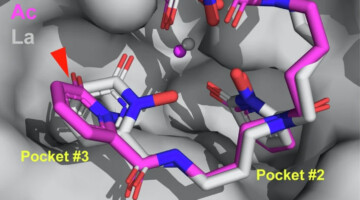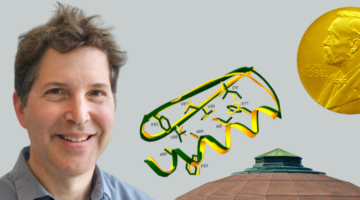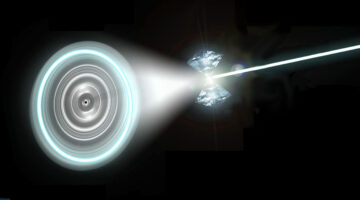Researchers used x-ray crystallography at the ALS to characterize how two newly discovered antibodies prevent the protein interactions responsible for severe malaria. Understanding this mechanism offers novel insights for vaccine development. Read more »![]()
![]()
A Macromolecular Scaffold for Probing Actinium Chemistry
By encapsulating actinium atoms within a macromolecular complex for analysis using protein crystallography, researchers discovered that actinium has a unique solid-state bonding configuration. A better understanding of actinium behavior could help improve a promising cancer treatment known as targeted alpha therapy. Read more »![]()
![]()
Lattice-Dependent Spin Textures in High-Tc Superconductors
Researchers found that in bismuth-based cuprate superconductors, charge imbalances caused by lattice distortions generate persistent and universal patterns of spin polarization. The results supply a previously missing but essential ingredient in efforts to understand the mechanisms driving the electronic behavior of high-temperature superconductors. Read more »![]()
![]()
Magnetization Switching in Highly Magnetostrictive Microstructures
Researchers learned how the size, shape, and orientation of microstructures affect how they switch magnetization directions in response to an applied voltage. The work advances our understanding of strain-responsive composite materials for use in energy-efficient electronic applications such as memory devices, sensors, and actuators. Read more »![]()
![]()
Studying Interfacial Effects in Solid-Electrolyte Batteries
An ambient-pressure probe of a solid electrolyte revealed how surface electrochemical mechanisms lead to poor electrolyte performance and battery failure. The results can help scientists engineer better coatings and interfaces, which are essential for building safer and better-performing batteries, particularly for use in vehicles. Read more »![]()
![]()
Protein Pioneer: Enabling Scientists to Design Novel Proteins for the Future
The 2024 Nobel Prize in Chemistry was awarded to David Baker, Demis Hassabis, and John M. Jumper for the development of protein structure prediction and design. At the ALS, Baker leveraged high-throughput small-angle x-ray scattering (SAXS) and protein crystallography capabilities to design novel proteins and pave a new pathway for science, technology, and the environment. Read more »
A New Way to “Squeeze” Infrared Wavelengths Down to Size
Researchers demonstrated a new way to confine, or “squeeze,” infrared light by coupling photons with phonons (lattice vibrations) within a certain type of thin film. The work heralds a new class of optical materials for controlling infrared light, with potential applications in photonics, sensors, and microelectronic heat management. Read more »![]()
![]()
Converting N2 into Usable Form under Ambient Conditions
Researchers learned how molecular structure relates to function in catalysts that convert atmospheric nitrogen into more usable forms at room temperature and pressure. The work could lead to greater energy efficiency in producing nitrogen-based products such as fertilizer where large-scale industrial processes are unfeasible. Read more »![]()
![]()
Superhard Materials at the Nanoscale: Smaller is Better
In the superhard material, rhenium diboride, smaller grain size leads to greater yield strength (i.e., the amount of stress tolerated before permanent deformation). Because such transition-metal borides are extremely hard, metallic, and can be synthesized at ambient pressure, they have exciting potential for use in next-generation cutting tools. Read more »![]()
![]()
How Bulky Molecules Improve Next-Generation Solar Cells
Adding “bulky” organic molecules earlier in solar-film synthesis slows crystal growth, leading to the formation of a protective surface layer that improves durability and efficiency. These next-gen materials could revolutionize solar-cell technology, offering increased efficiency, lower cost, lighter weight, and flexible solar modules. Read more »![]()
![]()
- « Previous Page
- 1
- 2
- 3
- 4
- …
- 13
- Next Page »









